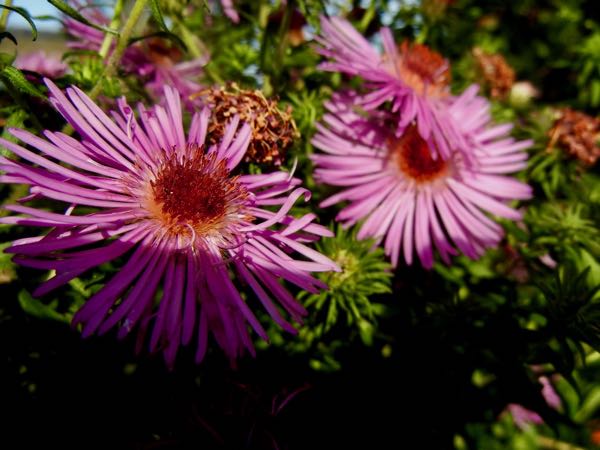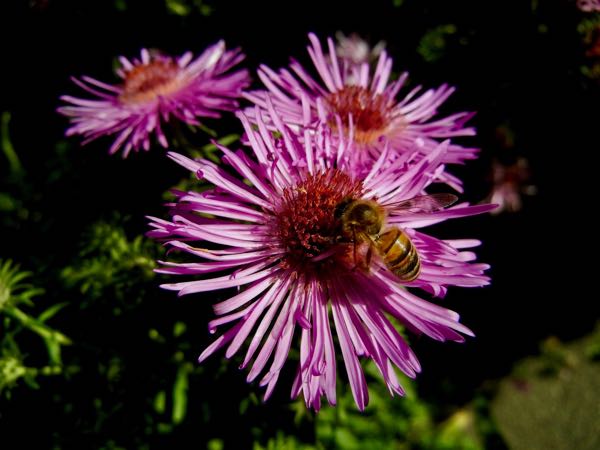Aster novae-angliae ‘Barr’s Pink’: A Charming Late-Season Perennial
Background and Family: Aster novae-angliae ‘Barr’s Pink’, also known as New England Aster ‘Barr’s Pink’ or Michaelmas Daisy ‘Barr’s Pink’, belongs to the Asteraceae family. Native to North America, it is closely related to Chrysanthemums and Sunflowers. The name “Aster” is derived from Greek, meaning “star.”
Origin and Discovery: Aster novae-angliae ‘Barr’s Pink’ was first introduced or discovered in [Year/Details of Discovery]. Its captivating beauty and hardiness have made it a popular choice among gardeners.
Characteristics and Description: This herbaceous perennial forms clumps and can reach a height of 4ft (120cm). The lance-shaped green leaves provide an attractive backdrop for the abundant daisy-like flowers. The flowers of ‘Barr’s Pink’ are purple-pink with vibrant yellow centers, creating a striking contrast. One fascinating trait of this aster is its sensitivity to light: the flowers droop during periods of darkness and open up with the arrival of sunlight.
Fragrance and Flowering Season: Aster novae-angliae ‘Barr’s Pink’ has a delightful fragrance that adds to its allure. It blooms from summer through autumn, with flowers typically appearing from July to October. This extended flowering season brings vibrant colors and beauty to the late-season landscape.
Cultivation of Aster novae-angliae ‘Barr’s Pink’:
Sunlight: For optimal growth and flowering, plant ‘Barr’s Pink’ in a location that receives full sun or partial shade. Adequate sunlight ensures the plant’s vitality and abundant blooms.
Watering: During the first year after planting, provide regular watering to establish Aster novae-angliae ‘Barr’s Pink’. Once established, it becomes more drought-tolerant but may still benefit from occasional watering during dry periods.
Soil: ‘Barr’s Pink’ adapts well to various soil types but thrives in moist, well-drained soil. It shows good tolerance to different soil conditions, including salt and wet soil.
Pests and Diseases: Aster novae-angliae ‘Barr’s Pink’ exhibits relative resistance to pests and diseases. However, it can be susceptible to powdery mildew, especially in humid climates. Regular monitoring and prompt action, such as applying a fungicide, can help control and prevent powdery mildew.
Propagation:
You can propagate Aster novae-angliae ‘Barr’s Pink’ through seed, division, or root cuttings. Seeds can be sown in either fall or spring, allowing for natural growth and new plants to emerge. The division is a straightforward and commonly used method. Carefully separate the roots using a sharp knife and transplant the divisions to desired locations. Root cuttings can be taken in spring or fall to propagate and expand the presence of this charming perennial.
Maintenance and Pruning: After flowering, it is recommended to cut back the plants to the ground. This practice encourages new growth in the fall and helps maintain the plant’s vigor. If self-seeding is undesired, cutting back the plants after flowering can help control self-seeding.
Deer and Rabbit Resistance: Aster novae-angliae ‘Barr’s Pink’ displays resistance to deer and rabbits, making it a suitable choice for gardens where these animals may be present.
With its captivating pink flowers, delightful fragrance, and ability to enliven the late-season garden, Aster novae-angliae ‘Barr’s Pink’ is a cherished perennial that adds a touch of elegance and color to any landscape.


Also, read about Aster novae-angliae ‘Andenken an Alma Potschke’



